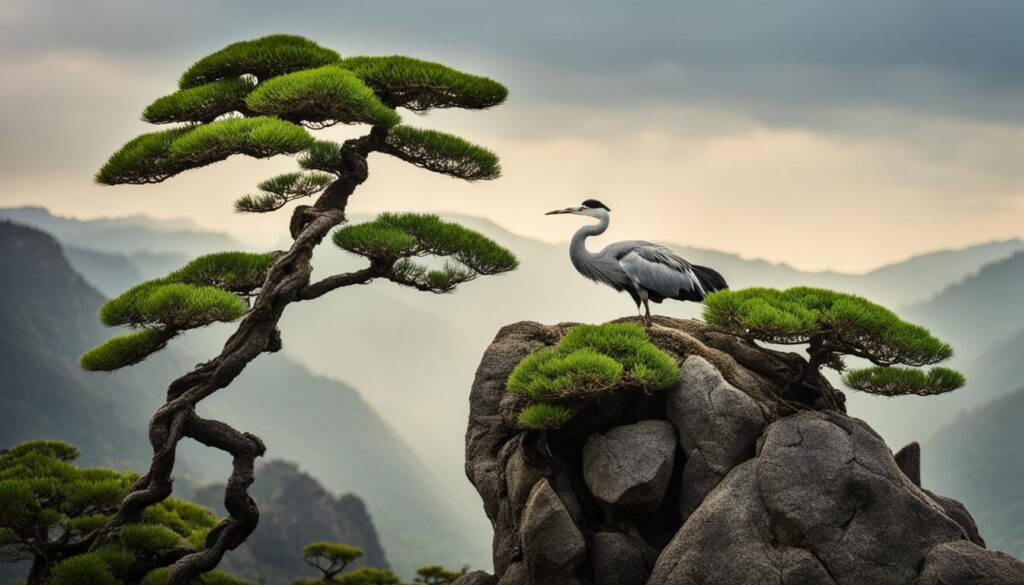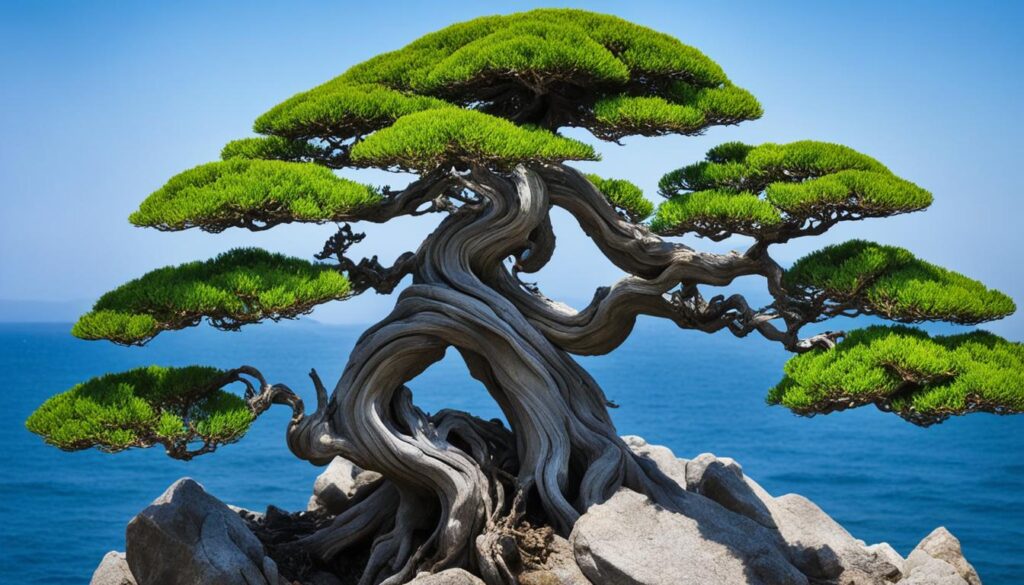Imagine miniature trees, cultivated to grow on rocks, creating stunning landscapes. This article explores the practice of growing bonsai on rocks, also known as bonsai rock. Learn how this art form combines creativity and nature to create living masterpieces.
Discovering the Art of Bonsai Rock

The art of bonsai rock has roots in ancient China and has gained popularity in Japan and beyond. Bonsai rock involves creating miniature landscapes that imitate the beauty of nature. Selected rocks serve as the foundation for bonsai trees, adding depth to these works of art.
This section explores the history and philosophy behind bonsai rock, outlining the techniques and principles that guide this art form. Understanding the art of bonsai rock helps you create stunning compositions using ordinary rocks.
Choosing the Perfect Rock for Your Bonsai
Choosing the right rock is crucial for creating a visually striking bonsai rock planting. A rock with character can enhance the aesthetic appeal of your bonsai. This section discusses key factors to consider when selecting the perfect rock.
Finding a Rock with Character
A rock with character features distinct aspects, such as unique textures, patterns, or shapes. These qualities create natural beauty and visual interest in your bonsai rock planting. Look for weathered rocks, as they tend to have more character. Rocks with natural erosion and color variations can further enhance the appeal.
Handmade Versus Natural Rocks
You can find both handmade and natural options when selecting a rock for your bonsai. Handmade rocks, or “suiseki,” are shaped by artisans to achieve specific artistic qualities. They are valued for their intricate designs.
Natural rocks are formed by nature and offer an authentic feel. Consider your preference and the aesthetic you want when choosing between handmade and natural rocks.
Positioning Your Bonsai: The Aesthetics of Balance
The positioning of your bonsai on the rock is crucial for balance and harmony. The aesthetics of balance involve considering the size and shape of both the bonsai tree and the rock. Aim for a pleasing arrangement where proportions complement each other. Experiment with angles and positions to achieve the desired aesthetic effect.
Selecting Bonsai Species for Rock Planting

Not all bonsai species thrive when planted on rocks. This section discusses the best bonsai species for rock planting, helping you choose the right trees for stunning bonsai rock landscapes.
Junipers: The Versatile Choice
Junipers are among the best bonsai species for rock planting. Their adaptable nature and resilience make them ideal for this cultivation method. Junipers allow for various styles, from cascading branches to windswept forms. Their deep green foliage contrasts beautifully with rocks, creating striking compositions.
Pine Trees: Embodying Strength and Longevity
Pine trees are another excellent choice for bonsai rock plantings. They symbolize strength and longevity, adding character to rock landscapes. Their evergreen needles and distinctive bark create harmony and timelessness. Pine trees have structured growth patterns, making them ideal for balanced bonsai rock designs.
Deciduous Trees: Adding Variety to Bonsai Rock Landscapes
Deciduous trees, such as maple, cherry, and birch, introduce vibrant colors and seasonal changes to bonsai rock gardens. These trees shed leaves in fall, revealing intricate branch structures that enhance the landscape.
The contrasting textures of rocks and bare branches create visual engagement year-round. Incorporating deciduous trees in your bonsai rock planting adds diversity and natural beauty.
By selecting suitable bonsai species for rock planting, like junipers, pines, and deciduous trees, you can ensure the health and aesthetic appeal of your bonsai rock compositions.
Bonsai Rock Care and Maintenance
Proper care and maintenance are vital for the health of bonsai rock plantings. Follow these essential practices to maintain a thriving bonsai rock landscape.
Watering:
Water is essential for bonsai rock survival. Keep the soil moist but not waterlogged. Water your bonsai rock thoroughly until water drains from the bottom. Regularly monitor moisture levels and adjust your watering schedule to prevent under or overwatering.
Fertilizing:
Provide regular nutrients to support growth. Use a balanced liquid fertilizer formulated for bonsai trees. Follow the product label instructions and fertilize at recommended intervals during the growing season.
Pruning:
Regular pruning helps maintain the desired size and shape of your bonsai rock. Use clean bonsai pruning shears to trim branches and foliage. Remove dead or damaged parts and shape the plant for aesthetic appeal. Pruning should occur during the appropriate season for the bonsai species.
Protecting from Environmental Factors:
Bonsai rocks face various environmental conditions, including extreme temperatures and wind. Position your bonsai rock in a location offering adequate shade and shelter from harsh weather. Consider using shade cloth or moving your bonsai rock indoors during extreme conditions.
Monitor your bonsai rock’s health and address any issues promptly. Inspect for signs of pests, diseases, or nutrient deficiencies. Proper care will help your bonsai rock thrive and remain a captivating centerpiece in your garden or indoor space.
The Role of Soil in Bonsai Rock Planting
The choice of soil is crucial for successful bonsai rock plantings. The right soil mixture provides essential nutrients, promotes healthy root growth, and ensures proper drainage. This section guides you on mixing the right soil for your bonsai rock and emphasizes drainage and retention.
Mixing the Right Soil for Rock Bonsai
Creating the ideal soil mixture is essential for plant well-being. The right combination provides adequate water retention and aeration. One popular component for bonsai rocks is akadama, a clay-like substance that promotes drainage and root development.
Another common component is garden mold, which helps retain moisture. Mixing akadama and garden mold in the right proportion creates a balanced soil mixture for optimal growing conditions.
Using Keto to Secure the Soil
Stability is important when planting bonsai on rocks. Using Keto can help secure the soil in place. Keto is a sticky river mud from Japan that acts as a bonding agent to hold the soil together, preventing washouts. Applying a thin layer of Keto over the soil surface ensures that roots remain anchored to the rock.
Understanding Drainage and Retention
Drainage and moisture retention are crucial when planting bonsai on rocks. Proper drainage ensures excess water flows out, preventing root rot. Moisture retention keeps roots hydrated between watering. Achieving the right balance between drainage and retention is key for health. Provide drainage holes in the rock and use a well-balanced soil mixture to ensure free water flow while retaining moisture.
| Soil Components | Properties |
|---|---|
| Akadama | Promotes drainage and root development |
| Garden Mold | Retains moisture |
| Keto | Secures the soil and prevents erosion |
Styles and Symbolism in Bonsai Rock Design
Bonsai rock design has many styles, each with its symbolism. Exploring these styles helps create visually striking compositions that reflect personal taste.
One popular style is the cascade style, which mimics a tree growing on a mountainside, with branches cascading downward. This style symbolizes strength and resilience.
Another captivating style is the windswept style, imitating the effect of strong winds shaping a tree’s growth. This style symbolizes perseverance and adaptability.
The root over rock style involves growing a bonsai tree with roots entwined around a rock, creating a dramatic visual effect. This style symbolizes the deep connection between nature and the bonsai tree.
Understanding the symbolism behind different bonsai rock styles allows you to create meaningful compositions. Whether you choose cascade, windswept, or root over rock, each design tells a unique story. Experiment with styles and let your creativity guide you in creating memorable bonsai rock compositions.
Creating Your Own Bonsai Rock
Creating your bonsai rock planting is a wonderful opportunity to express your creativity and passion for bonsai. By combining rocks and bonsai trees, you can create an enchanting miniature landscape. This section guides you through planting bonsai on rocks, nurturing and shaping them over time.
Step-by-Step Guide to Planting
Begin by selecting a suitable tree species for growing on rocks. Popular choices include junipers, pines, and deciduous trees. Once you have selected your tree, follow these steps:
- Select a rock with character and unique features, ensuring it provides a stable foundation.
- Clean the rock thoroughly, removing any dirt or debris.
- Create a suitable soil mixture using ingredients like akadama and garden mold.
- Place a layer of soil on the rock for a stable base.
- Position the bonsai tree on the rock, aligning the roots with the soil layer.
- Add more soil around the roots, securing them in place.
- Water the bonsai thoroughly to settle the soil.
By following these steps, you can successfully plant your bonsai on a rock, creating an eye-catching composition.
Nurturing and Shaping the Bonsai Over Time
After planting your bonsai, providing proper care is essential for its health. Here are some nurturing practices:
- Regularly water the bonsai to keep the soil moist but not waterlogged. Check soil moisture by inserting your finger; if it feels dry, water.
- Prune the bonsai to maintain its shape and encourage growth. Remove dead or overgrown branches.
- Protect the bonsai from extreme weather, moving it to a sheltered location if needed.
- Provide adequate sunlight for the bonsai based on its species needs.
With proper nurturing, your bonsai tree will thrive and achieve its desired form.
Tips for Securing Bonsai to Rocks
Securing the bonsai to the rocks is crucial for stability. Here are tips to ensure a secure attachment:
- Use wire or bonsai tie to hold the roots in place and prevent movement.
- Wrap the wire around the roots and secure it to the rock, ensuring it is tight but not constricting.
- Monitor the attachment over time and adjust as necessary to accommodate root growth.
By following these tips, you can secure your bonsai to the rocks effectively, allowing it to thrive.
Bonsai Rock Techniques: Root Over Rock Methodology
The root over rock technique is visually striking and involves shaping the roots of a bonsai tree to cascade over a rock, creating harmony. Here are the key steps to master this technique:
Prepping Your Rock and Tree for the Root Over Rock Style
Select a suitable rock that complements your bonsai tree. The rock should have crevices for the roots. Clean the rock and examine your bonsai for a flexible root system that can grow over the rock.
Wrapping and Securing the Root Structure
Gently wrap roots around the rock’s surface using bonsai wire. Ensure the wire is wrapped firmly but allow room for the roots to expand. Secure the wire ends to prevent unwinding and keep roots in place.
The Importance of Patience: Growth and Development Over Years
Growing a root over rock bonsai requires patience. It takes time for roots to establish and adhere to the rock. Provide necessary care, including regular watering, fertilizing, and pruning, to support growth. Over the years, roots will strengthen and intertwine with the rock, resulting in a stunning bonsai.
By following these steps and exercising patience, you can master the root over rock technique and create breathtaking bonsai rock compositions. The combination of rocks and roots will elevate your bonsai artistry.

Karen Phillips, Bonsai expert and blogger. Read more about me here



